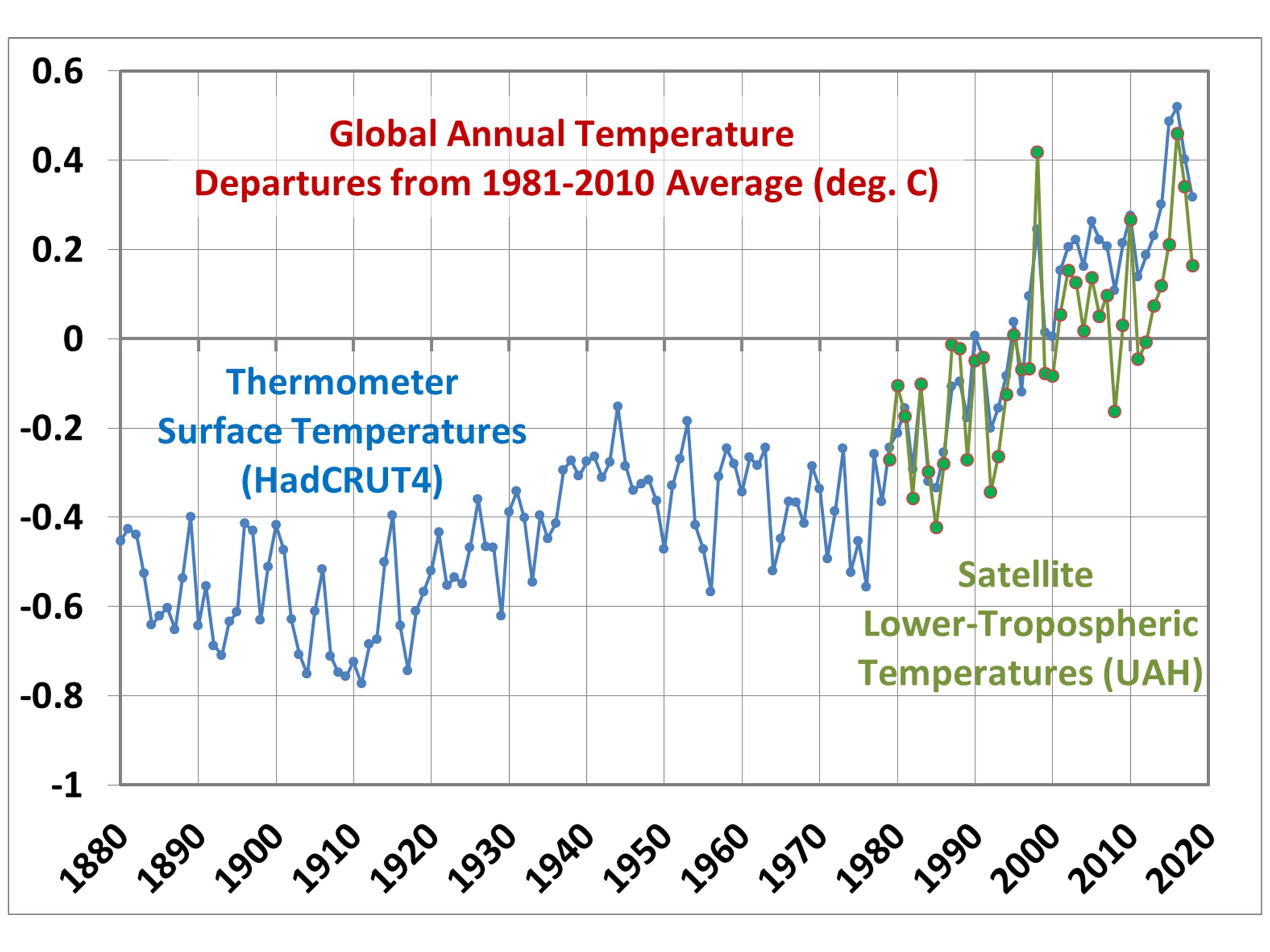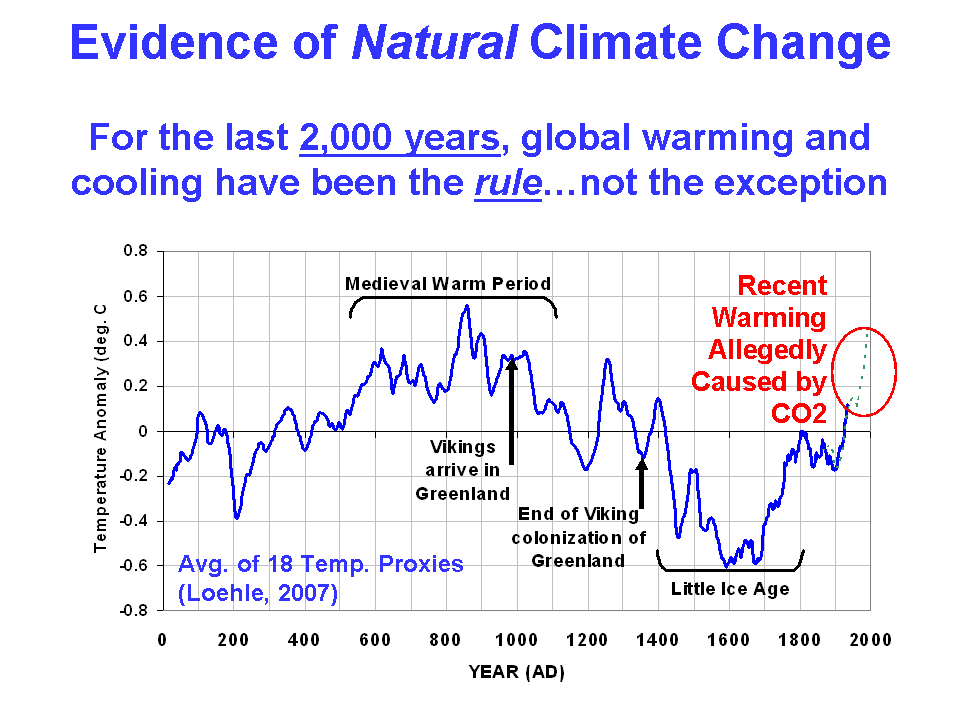

|

|
What is global warming? |
| In its most commonly used sense, 'global warming' refers to the gradual increase of global average temperatures
due to the slowly increasing concentrations of man-made atmospheric greenhouse gases, primarily carbon dioxide. But global warming
can also refer more generally to the observation of warming, no matter the cause.
As seen in the above chart, there have been two main episodes of warming in the last 100 years or so...before 1940, and then from the 1970s to about 2000. Warming slowed considerably around 2000, but then the 2015-16 El Nino ended that period of reduced warming, at least temporarily. The most popular explanation for global warming is the burning of fossil fuels, mainly petroleum and coal, which produces carbon dioxide as one of the by-products. As of 2019, the concentration of carbon dioxide is about 50% higher than it was before the start of the industrial revolution in the late 1800's. The potential warming effect of the extra CO2 is through its ability to absorb and emit infrared radiation, which is the type of radiation the Earth continually loses to outer space in response to heating by sunlight. This makes carbon dioxide a greenhouse gas, albeit a weaker one in the atmosphere than water vapor. The net effect of greehouse gases is to keep the lower layers of the atmosphere warmer that they otherwise would be without those gases. They act as a "radiative blanket". Therefore, it has seemed reasonable to assume that an increase in greenhouse gases would lead to warming. But the big question is, how much warming? How serious will global warming be? We don't know for sure, and there is much debate in the climate research community over this very question. The consensus of opinion is that a warming of about 0.3 degrees Celsius (about 0.5 deg. F) every 10 years is expected for the next 100 years or so. The computerized climate models that predict warming have produced somewhat more warming than had been observed, the reasons for which are unknown. The reason why there is so much uncertainty, though, is not because of the direct warming effects of more carbon dioixde, which are relatively weak. The main uncertainty is whether clouds and other components of the climate system will change in a way that amplifies -- or reduces -- the relatively weak warming effect of the extra carbon dioxide. These indirect effects are called "feedbacks", and they will largely determine the extent to which manmade global warming is a problem or not. Another source of uncertainty is the role of anthropogenic aerosol pollution, which is believed to have offset the CO2-induced warming, but by an uncertain amount. The processes by which clouds and water vapor -- the 2 main feedbacks -- are maintained in the atmosphere are very complex. For instance, clouds (on a whole) act to cool the Earth in response to heating by the sun. But the consensus of scientific opinion is that this will reverse with the slight warming from increasing carbon dioxide. Again, how clouds will change with global warming will be critical, as they could either amplify the warming, or reduce it. While water vapor feedback is more widely accepted to be an amplifying influence on warming, this is not obvious since warming-induced change in precipitation formation processes in rain systems is not well understood, and could cancel out the greater surface evaporation rates that would accompany surface warming. If those rain systems become more efficient at converting water vapor into precipitation, this would act to offset global warming. Cloud and precipitation-related feedbacks are so uncertain that it is difficult to assign any level of confidence to global warming projections. But what about the warming to date? While there is some controversy over just how much warming has occurred over the last 50 to 100 years, it is pretty certain that warming has, indeed, occurred. None of our temperature observation systems were designed to monitor such a slow rate of warming, which has led to uncertainty as observational methods and instrumentation have changed over the years. But is that warming unusual? The following plot shows an average of 18 different temperature proxies over the last 2,000 years (not including tree rings, which many believe to be unreliable indicators of temperature): 
As can be seen, every century shows evidence of global warming or global cooling. What could cause such changes? No one knows for sure, although there are a few ideas, mostly related to natural variations in global cloud cover. These changes in Earth's natural "sun shade" need be only 1% or 2% to cause global warming -- or cooling. In fact, it is entirely possible that a significant fraction of the warming in the last 50-100 years has been natural. Even the United Nations Intergovernmental Panel on Climate Change has officially stated only that "most" of the warming since the 1950s has been huamn-caused. To the extent that some of the recent warming has been natural, tis would necessarily mean that future manmade warming will likely be weaker than that produced by climate models, since those models assume all long-term warming is human-caused. Finally, the potential role of the oceans in global temperature change is not well understood. Most of the oceans below a few hundred feet depth are very cold, and so a change in the overturning circulation of the ocean can cause warming or cooling. Because the ocean (and the atmosphere) is a nonlinear dynamical system both are subject to chaotic changes without any external forcing. Science would have difficulty predicting any such chaotic changes, if they exist. |
| (page last updated 12/13/2019) |
| SELECT BOX EXAMPLES: | ||
|
||
| Copyright © 2023 WeatherStreet.com |
| Put our free WeatherStreet weather lookup on your web page. |
Terms & Conditions

|
|
|